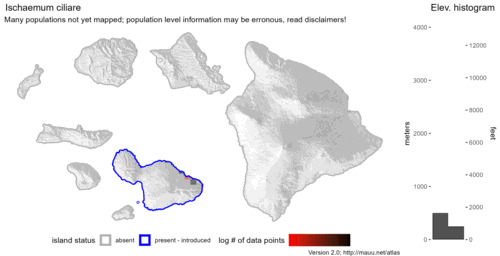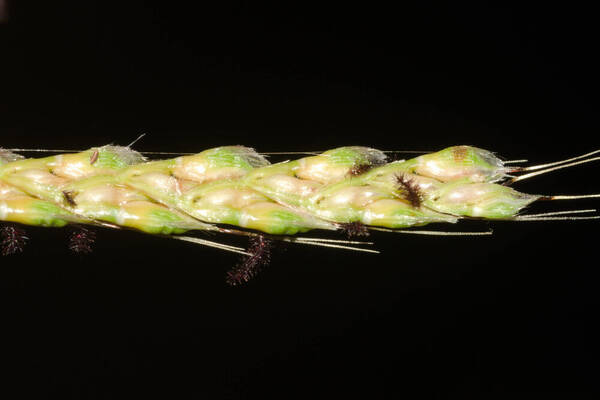Info
Subfamily: Panicoideae
Genus etymology: Ischaemum = "to stop bleeding" [Greek] referencign supposed medical uses
Species etymology: ciliare = "ciliate" [Latin] refering to the hairs of the pedicels
Photosynthetic type: C4 (warm season)
Nativity: naturalized - accidental
First recorded in Hawaiʻi: 1941
Map

Inflorescence

Plant

Spikelets



Collar

Description
Habit: Perennial; mat forming. Stolons present. Culms prostrate; 20-60 cm long; rooting from lower nodes. Culm-nodes glabrous, or bearded. Ligule an eciliate membrane; 0.8-2 mm long. Leaf-blade base broadly rounded. Leaf-blades 15-35 cm long; 2.5-4 mm wide. Leaf-blade surface hirsute; hairy on both sides. Inflorescences: Inflorescence composed of racemes. Racemes 2; paired; 2-10 cm long. Rhachis fragile at the nodes; angular; ciliate on margins. Rhachis internodes oblong; 2.5-3 mm long; flat and forming a U or V shape with the pedicel in rear view. Rhachis internode tip transverse; cupuliform. Spikelets in pairs. Fertile spikelets sessile; 1 in the cluster. Companion sterile spikelets pedicelled; 1 in the cluster. Pedicels oblong; ciliate. Sterile Florets: Companion sterile spikelets well-developed; containing empty lemmas, or male; lanceolate; laterally compressed; 4-4.5 mm long; shorter than fertile; separately deciduous. Companion sterile spikelet glumes chartaceous; keeled; winged on keels; 11 -veined; mucronate. Companion sterile spikelet lemmas 2; enclosed by glumes; 1-awned; with 7-9 mm long awn. Spikelets: Spikelets comprising 1 basal sterile florets; 1 fertile florets; without rhachilla extension. Spikelets oblong; dorsally compressed; 5-6 mm long; falling entire; deciduous with accessory branch structures. Spikelet callus pilose; base truncate; inserted. Companion sterile spikelets well-developed; containing empty lemmas, or male; lanceolate; laterally compressed; 4-4.5 mm long; shorter than fertile; separately deciduous. Companion sterile spikelet glumes chartaceous; keeled; winged on keels; 11 -veined; mucronate. Companion sterile spikelet lemmas 2; enclosed by glumes; 1-awned; with 7-9 mm long awn. Fertile Spikelets: Spikelets comprising 1 basal sterile florets; 1 fertile florets; without rhachilla extension. Spikelets oblong; dorsally compressed; 5-6 mm long; falling entire; deciduous with accessory branch structures. Spikelet callus pilose; base truncate; inserted. Glumes: Glumes dissimilar; exceeding apex of florets; firmer than fertile lemma. Lower glume oblong; 0.8 length of spikelet; coriaceous; much thinner above; 2-keeled; keeled above; keeled laterally; winged on keel; winged broadly; winged above; 8-9 -veined. Lower glume surface convex; glabrous, or pilose. Lower glume apex dentate; 2 -fid. Upper glume lanceolate; coriaceous; much thinner above; 1-keeled; keeled above; winged on keel; winged above; 5 -veined. Upper glume awned; 1 -awned. Upper glume awn 2-2.5 mm long. Florets: Basal sterile florets male; with palea. Lemma of lower sterile floret lanceolate; 3.75-4 mm long; 0.7-0.8 length of spikelet; membranous; 3 -veined. Fertile lemma oblong; 2-2.5 mm long; membranous; without keel; 3 -veined. Lemma apex lobed; 2 -fid; incised 0.5 of lemma length; awned; 1 -awned. Principal lemma awn from a sinus; geniculate; 9-20 mm long overall; with twisted column. Column of lemma awn glabrous. Palea 1 length of lemma. Flowers: Anthers 3; 2-2.5 mm long. Distribution: Africa: west tropical, west-central tropical, and western Indian ocean. Asia-temperate: China and eastern Asia. Asia-tropical: India, Indo-China, and Malesia. South America: northern South America.
(Description source: Clayton, W.D., Vorontsova, M.S., Harman, K.T. and Williamson, H. (2006 onwards). GrassBase - The Online World Grass Flora. Available at https://powo.science.kew.org )